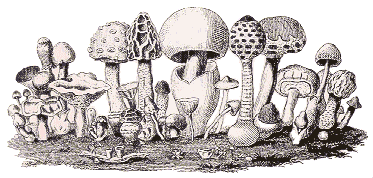Bruce refers to Calocera pallidospathulata as the Yorkshire jelly since it was first found in a plantation located between Scarborough and Pickering by Willis Bramley in 1969. Bramley recognized that he had found something unusual and sent a sample to Dr. Dennis A. Reid at the Royal Botanic Gardens, Kew. It turned out to be a species new to science that had not been reported anywhere in the world before. Reid named it Calocera pallidospathulata. The fruiting structure of C. pallidospathulata is always pale to start with unlike the other common species of Calocera (hence its recommended English name the Pale Stagshorn) but it produces a yellow pigment in the light and when mature the tip is spoon shaped. The fruit bodies which form a horny film in dry conditions but swell up again when wet are found on stumps and small pieces of wood. Germination experiments carried out by Professor C. T. Ingold showed that C. pallidospathulata was not a hybrid but a distinct species. Bruce has recorded the spread of C. pallidospathulata from its first appearance in Yorkshire to the present day.
Initially C. pallidospathulata spread to County Durham and in 1978 had been recorded in 27 sites reaching Lancashire and Delamere Forest in Cheshire. By 1980 C. pallidospathulata had spread to sites in Wales and in 1986 could also be found in the extreme south of Scotland in Dumfriesshire. By 1988 it had managed to leave our shores altogether reaching Norway associated Bruce believed with prevailing wind currents carrying its spores there. In 1989 as if by a sudden jump C. pallidospathulata had reached southern England where it was first recorded in the New Forest. Bruce surmised that it had possibly been transferred on the wheels of forestry vehicles. C. pallidospathulata then spread northeast into the Home Counties. The map indicates just how far C. pallidospathulata has spread from its original base in Yorkshire.
In addition to its rapid spread it appears from the records that C. pallidospathulata has also diversified in respect to its substrate initially being found only on conifer wood but later able to exploit various hardwoods and even being found on rhododendron. Bruce reported that when moving into new areas C. pallidospathulata is usually found on conifer first, then birch and then other hardwoods. Fortunately C. pallidospathulata is not pathogenic only growing on dead wood. It is a more vigorous competitor than native British species occupying similar habitats since it is not seasonal like Calocera viscosa (Yellow Stagshorn) and Calocera cornea (Small Stagshorn) but fruits all year round and has become even more common than Dacrymyces stillatus (Common Jellyspot) in some areas. However, more recently its movement has slowed down and it does not appear to be as common in places where it was once abundant. Bruce put forward two possible explanations firstly it may have mutated since its arrival in the British Isles because conditions are likely to be quite different from wherever it came from alternatively changes in the climate may have influenced its behavior.
Perhaps the most interesting question is where exactly C. pallidospathulata originated from. Initially it was thought that C. pallidospathulata must have been introduced into the tree nursery where it was first recorded with imported saplings from the Pacific Northwest Region (Oregon and Washington) of the United States. However, Bruce pointed out that there are no records of C. pallidospathulata being found in this area. Bruce went on to tell us an extraordinary story dating back to when he was in Mexico three years ago and had an opportunity to explore one of the many oak and pine forests found in the mountain regions. On the fallen trunk of a juniper he found a jelly fungus with all the characteristics of C. pallidospathulata. Bruce hypothesized that it is possible C. pallidospathulata is found in the mountain forests all along Central America. Quite how it managed to end up in Yorkshire remains a mystery. Bruce completed his talk by saying that C. pallidospathulata represented a simple model for the spread of an alien species of fungus in the British Isles although surprisingly it has not been well studied.
Reference
Ing, B. (1990) Profiles of fungi 25: Calocera pallidospathulata Reid. The Mycologist, 4, 34.
Map
10km squares with records for Calocera pallidospathulata in Great Britain and Ireland. The map was obtained from the NBN Gateway (www.searchnbn.net) [Note: dataset is acknowledged to the Fungal Records Database of Britain and Ireland provided by the British Mycological Society].

